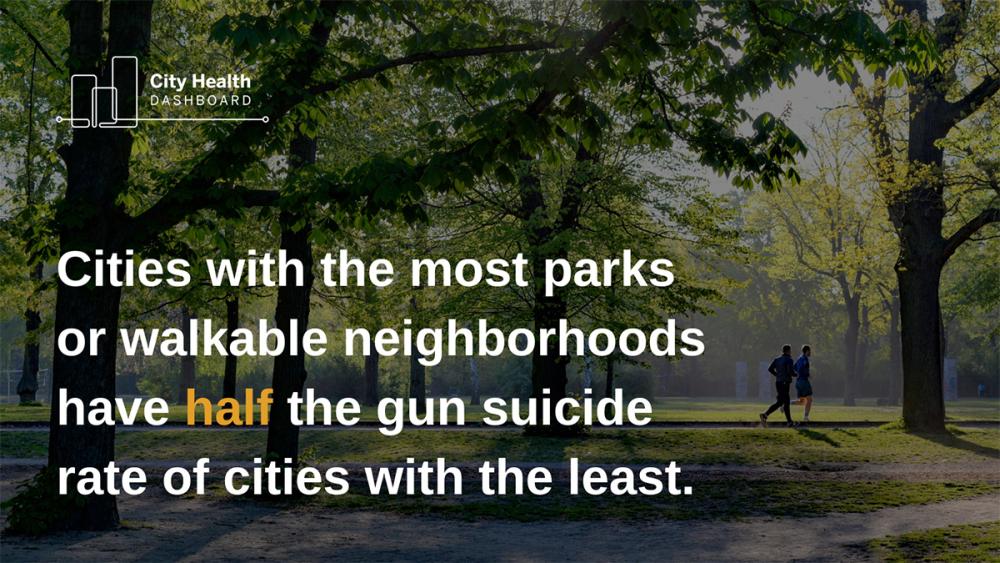City-Level Firearm Mortality Data—Publicly Available for the First Time—Highlights Toll of Guns on Hundreds of U.S. Cities

Photo: NYU Langone Staff
Four out of every 10 gun-related deaths in cities were suicides, an 11 percent increase since 2014, finds an analysis of firearm deaths in more than 750 U.S. cities from 2014 through 2020. Firearm homicide rates in cities also increased by approximately 18 percent, with a steep increase in 2020.
The findings are the result of a research collaboration between NYU Langone Health’s City Health Dashboard and the Everytown for Gun Safety Support Fund—the country’s largest gun violence prevention organization. This toll reflects the consequences of years of easing restrictions on gun ownership and on carrying firearms in public, and of a sharp spike in gun sales during the first year of the pandemic, say the authors of the analysis.
These new analyses identify which cities had the most significant increases and decreases in both suicide and homicide firearm deaths—providing the most complete data on city-level firearm-related homicide and suicide rates, now available publicly.
“This is the largest release of city-level data on gun suicide and homicide rates from a trusted national data source,” says Marc N. Gourevitch, MD, MPH, the Muriel G. and George W. Singer Professor of Population Health and chair of the Department of Population Health at NYU Grossman School of Medicine, as well as the principal architect of the City Health Dashboard. “We are grateful for the opportunity to partner with Everytown and make this data publicly accessible so that stakeholders in more cities across the country have the information they need to reduce gun deaths and bolster community safety.”
The two new measures—firearm suicide and homicide rates—use data obtained through a data use agreement with the National Vital Statistics System (NVSS), the death records system of the Centers for Disease Control and Prevention (CDC). Until now, the only source of city-level data on firearm deaths was from the Federal Bureau of Investigation (FBI). Although valuable, there are conceptual and methodological differences in how the FBI data are calculated and reported.
Separately, the CDC also collects standardized data on firearm mortality from death certificates from all locales across the country. Today’s release of data by the City Health Dashboard marks the first time that these more complete and systematically collected CDC data have been analyzed to the city level, for hundreds of cities across the country.
These new measures further enrich the City Health Dashboard, an online, one-stop resource that allows users to view and compare data on more than 900 U.S. cities, drawing from multiple national data sources on health and the factors that shape health to guide solutions for creating healthier and more equitable communities. Since most health data are collected and reported at the county and state level, the City Health Dashboard serves a vital role as one of the few sources of city- and neighborhood-level health data.
Researchers from the City Health Dashboard and Everytown examined gun homicide data from cities with populations over 50,000 from 2014 to 2020. The analysis of firearm suicides revealed the following findings:
- Though homicide deaths in cities capture most of the headlines and public attention, nearly half (4 out of every 10) of gun deaths in cities are, in fact, suicides. And gun suicides are increasing in cities, up nearly 11 percent since 2014.
- Cities in states with the strongest gun violence prevention laws have about half the rate of gun suicides as those in states with the weakest laws.
- Cities with the most gun shops experience nearly four times higher gun suicide rates than those with the fewest, signaling the importance of expanding cities’ gun violence prevention efforts to include local gun dealers in addition to stemming illegal guns.
- Cities with the most parks or walkable neighborhoods have about half the rate of gun suicide as those with the fewest, suggesting that cleaning, greening, and lighting efforts may offer benefits in reducing gun suicides in addition to their known benefits in reducing gun homicides.
- Smaller cities experience higher gun suicide rates, underscoring the importance of adequate access to mental health resources and networks of social support.
- Cities with the highest rates of gun suicides include Bradenton, Florida; Cheyenne, Wyoming; Lake Havasu City, Arizona; Sarasota, Florida; and Grand Junction, Colorado.
“To address gun violence in our cities, we need to acknowledge the growing—and too often unspoken—role that gun suicide plays in the human toll of this epidemic,” says Meg O’Toole, deputy director of research at Everytown for Gun Safety. “This analysis unveils the scope of people who die by suicide and highlights the need to broaden the concept of city gun violence to recognize, prevent, and solve this pressing public health concern.”
Since launching in 2018, city leaders and policymakers have used the City Health Dashboard’s measures to identify health disparities, create data-driven health solutions, and benchmark health outcomes against similar communities. The Dashboard provides these new firearm metrics thanks to funding and collaboration with Everytown Research and Policy, to help city leaders and advocates make data-driven decisions about gun violence in communities. As with other City Health Dashboard metrics, new years of data will be added over time.
[Note: The mortality data used in this analysis are not released as microlevel downloadable datasets from the National Center for Health Statistics (NCHS)/Research Data Center (RDC), but as aggregated data tables whose analyses were conducted per NCHS disclosure requirements in a secure environment and released as approved output. The findings and conclusions are those of the researchers and do not represent the views of the RDC, NCHS, or CDC. NCHS does not recommend further analysis of this data because linking them to individually identifiable data from other NCHS or non-NCHS datasets could cause disclosure risks. If you believe a disclosure has occurred, please contact info@cityhealthdashboard.com and RDCA@cdc.gov.]
About the City Health Dashboard
More than 80 percent of U.S. residents live in urban areas. However, until recently, few measures have been available for cities to assess health, the factors that shape it, and the drivers of health equity. The City Health Dashboard provides city leaders with an array of regularly refreshed data to support health policies and equity-related decision-making.
With support from the Robert Wood Johnson Foundation, the City Health Dashboard provides more than 40 measures of health and its drivers for more than 900 cities and towns—those with a population of 50,000 and larger and a growing set of smaller locales. Equipped with these data, local leaders have a clearer picture of the challenges facing their communities and how to address them.
Media Inquiries
Sasha Walek
Phone: 646-501-3873
sasha.walek@nyulangone.org

